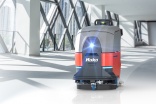Home › magazine › product features › High tech scrubbing
High-tech scrubbing
13th of April 2023How ‘high-tech’ does a scrubber dryer need to be? ECJ looks at the growing use of technology in the scrubber dryer market and finds out how widely it is being adopted.
A scrubber dryer has just two functions: to scrub and to dry. But today’s technological advances are making these machines more sophisticated than ever Automated scrubber dryers with intelligent functions are becoming increasingly common as manufacturers seek to push the boundaries and stand out from the crowd. But how popular are such refinements with customers?
Are they embracing the technology, or do they simply want a machine that works faster and more efficiently than a mop?
Technological innovations can offer increased speed, enhanced efficiency, greater transparency and better monitoring, says LionsBot ceo and co-founder Dylan Ng. “Technology also reduces reliance on human operators and helps to improve cleaning consistency, which is an important advantage,” he said.
“Scrubber dryers are becoming increasingly connected and more capable of relaying telematics information. And many robotic solutions can now clean autonomously without any human intervention.”
LionsBot offers a range of smart cleaning robots including scrubber dryers. “Besides being able to clean for longer and more effectively, these machines also provide enhanced monitoring and data reporting which allows them to be managed more efficiently over time,” said Ng.
“We have witnessed an increase in both supply and demand for automated and intelligent machines. Customers want a clean floor, but they are also looking for workable solutions that will solve their labour shortages.”
The future of the industry can be summed up in two words - 'connected cleaning' according to Kärcher’s floorcare product manager Christian Mrowka. “Developments in robotics and sensor technology are progressing steadily and the possibilities are growing,” he said.
“Technology - and robotics in particular - can save time and reduce the need for manual work. It cuts down on the effort required for floor cleaning and frees up staff to take on more complex tasks.”
New technologies are allowing scrubber dryer operators to carry out their work with greater ease, he says. ”For example, fast-charging batteries take away the downtime problem that arises when the operative may have forgotten to charge the machine overnight,” he said. “Sensors are also able to precisely predict the status of the machine so that usage time can be maximised. And apps and online content for status updates are replacing printed documents.”
The chief function of an automatic scrubber dryer is to minimise the need for human intervention, according to Mrowka. “Robots are primarily a response to today’s staff shortages and wage rises,” he said. “As labour costs continue to increase, customers are demanding new solutions to reduce the overall cost of cleaning. And robots represent a particularly good solution in areas where repetitive, monotonous work needs to be carried out.”
Reducing need for manual work
Automatic machines are becoming popular in retail, logistics, healthcare, transport and production environments, he claims. “Cleaning in these areas takes up a great deal of time and leads to high costs,” he said.
There has recently been a rapid growth in the use of robotics, according to Mrowka. “However, customers in production and logistics environments who are often already accustomed to robots find them easier to adopt than, say, purchasers in the retail sector where autonomous cleaning devices represent new territory.”
Kärcher’s KIRA B 50 automatic scrubber dryer is said to be equipped with efficient sensors and laser scanners to ensure reliable navigation. A docking station and lithium ion battery enables independent charging while the operating concept is claimed to be intuitive for easy configuration. And the machine is capable of cleaning close to edges, says Mrowka.
The introduction of automatic scrubber dryers has been a journey, he says. ”When the first scrubber dryer robots were launched, the only people capable of creating a route plan were service engineers with technical equipment and specialist programming knowledge,” he said. “But there are now many robots on the market that are simpler to operate, removing the barrier for potential customers.”
One downside of robots, he adds, is they can undermine cleaners’ independence and their sense of responsibility. “However employees appreciate the fact some physically demanding work is being removed from their remit,” he said. “When a robot takes over the monotonous task of large-scale floor cleaning outside of business hours it allows human cleaners to concentrate on more specialised work.”
He says studies forecast a global growth in the service robotics market – something that today’s technological advances is making increasingly viable.
“In our opinion, the scope of autonomous scrubber dryers will increase significantly in the near future as both smaller and larger devices come onto the market,” he said. “But in the medium term there will continue to be many applications that require manual cleaning.”
Technology is increasingly removing the tedious and repetitive tasks from the cleaner’s remit, says Wetrok’s scrubber dryer product manager David Klauser. “We are convinced that simple cleaning processes can be taken over very competently by intelligent cleaning machines,” he said. “This frees up staff to concentrate on more complex tasks which in turn adds value for the robot.”
He says hybrid machines are a good complementary solution and can help to cover staff absences. “Automated cleaning offers advantages such as high efficiency, a consistent cleaning quality and transparency since reports may be generated for each room,” he said.
“Autonomous machines can also compensate for labour shortages while absorbing seasonal peaks and decreasing costs in the long run.”
Wetrok has an in-house research and development infrastructure plus a test centre for its new machines. The company’s Marvin hybrid robot is said to be sufficiently compact to allow it to clean in narrow corridors and furniture-filled rooms. And it is designed to look like a conventional scrubber dryer because the appearance of a robot can be off-putting to some, according to Klauser.
Smart technology
Unlike Wetrok and Kärcher, IPC currently offers no robotic scrubber dryers. But the company makes extensive use of technology in the form of GPS Telematics, lithium ion batteries and an APC system which is said to double the machine’s productivity, according to floorcare product manager Paolo Bassanini.
“These technologies result in increased productivity and cleaning speeds while also providing greater transparency in performance,” he said. “We believe increased technology is the future of the scrubber dryer market.”
Hako’s application technology trainer and consultant Klaus Serfezi agrees that interest in autonomous machines has grown rapidly in recent years. “One of the chief reasons for this is the increasing shortage of skilled workers in the cleaning sector,” he said. “Our customers also recognise autonomous cleaning can be a support for operators, allowing them to take on other tasks on the side.”
New technological elements of a scrubber dryer may include a one-button operation, automatic brush discharge, automatic filling systems, on-board dosing and fill level indicators, he said. And other refinements are making cleaning more efficient and more transparent, according to Serfezi. “Fleet management systems allow operating times to be evaluated, and these can then serve as a performance record for clients,” he said.
Autonomous cleaning machines have not yet reached the mass market, according to Serfezi. “However their market share will increase in the future and they become established alongside manual machines.”
Any cleaner is capable of operating Hako’s machines without prior experience, he adds. The company’s Scrubmaster B75 I autonomous scrubber dryer can be equipped with a disc brush system or a cylindrical brush and side broom and is said to be reliable and cost-efficient. And the RoboScrub 20 from Hako’s PowerBoss brand is currently being used to clean large consumer spaces in the US.
According to Serfezi, today’s autonomous cleaning machines are particularly suitable for areas such as warehouses, retail centres, public buildings, airports and railway stations. “Wet cleaning in open areas works well today without the need for a great deal of time-consuming measuring of the surroundings,” he said.
Complex areas
“But the more complex the area to be cleaned, the higher the demands will be on the sensor technology and the software.”
And he adds that it is crucial the machine and the operator work in tandem, however changeable the environment might be. “They should work together as a team and the machine’s operation should be simple and intuitive,” he said. “In this way humans and autonomous systems are able to use their individual strengths for greater efficiency.”
But how do customers themselves feel about the technological revolution? Are they increasingly choosing automated scrubber dryers and machines that offer intelligent functions? Or do they simply want a model that works faster and more efficiently than a mop?
It all depends on the target market says IPC’s Paolo Bassanini. “Customers in the more advanced markets tend to choose automated scrubber dryers, whereas those in the less advanced markets are less likely to do so,” he said.
Hako’s Klaus Serfezi concurs. “It’s like everything else - there are purists and there are those who want to take everything technologically,” he said. “But provided the machine is well looked after and properly maintained, the cleaning result with an autonomous scrubber dryer will always be better than with a mop.”
The jury is out for Kärcher’s Christian Mrowka. “While interest in robotic machines is growing, we have found that demand for non-robotic machines has also increased,” he said. But Wetrok’s David Klauser says its customers are open to any intelligent functions that support them in their daily lives. “Both semi-autonomous and fully autonomous solutions are on the rise,” he adds.











